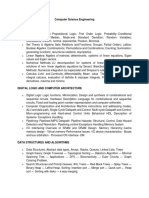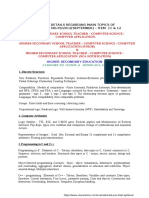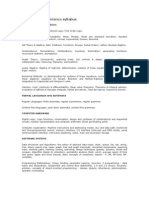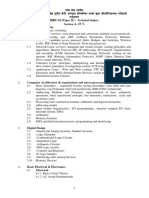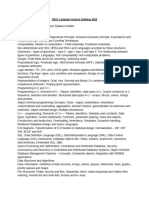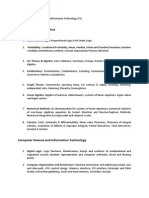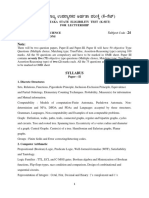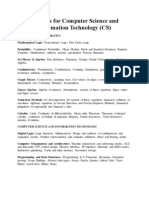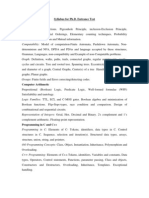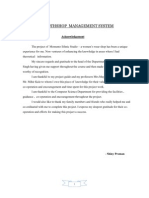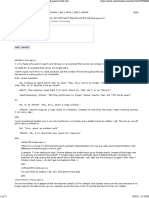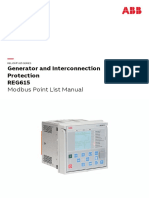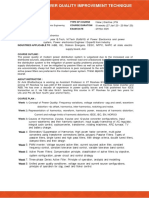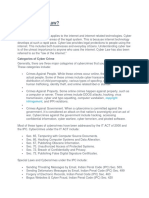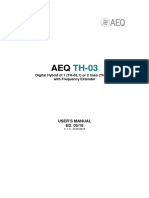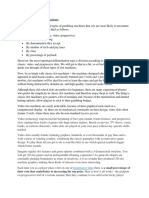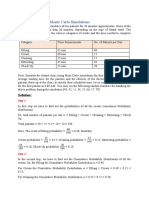Assistant Professor
Computer Engineering
(Syllabus)
FM: 100, PM: 40
Section A
1. Digital Design, Computer Architecture and organization and micro-processors:
1.1. Number Systems, Logic Elements, Combinational Logic Circuits
1.2. Sequential Logic, Arithmetic Circuits, MSI Logic Circuits. Counters and Registers,
1.3. IC logic families, Interfacing with Analog Devices, Memory Devices
1.4. Basic Structures: sequential circuits, design procedure, state table and state diagram.
Von Neumann I Harvard architecture, RISC/CISC architecture
1.5. Addressing Methods and Programs, representation of data, arithmetic operations, basic
operational concepts, bus structures, instruction cycle and excitation cycle
1.6. Processing Unit: instruction formats, arithmetic and logical instruction
1.7. Addressing modes
1.8. Input Output Organization: I/O programming, memory mapped I/O, basic interrupt
system, DMA 1.6 Memory Systems
1.9. 808X and Intel microprocessors: programming and interfacing Fundamentals of
electronics device and circuits
2. Artificial Intelligence:
2.1. Problem Solving: Problem definition, problem as a state space search, problem
formulation, problem types: Tor problems, Real world problems, Well-defined
problems, Constraint satisfaction problem (Basic concept & examples), Production
systems (Definition, Architecture, examples).
2.2. Search Techniques: Uniformed search techniques: depth first search, breadth first
search, depth limit search, Iterative deepening search, Bidirectional search, & search
strategy comparison. Informed search techniques: Greedy best first search, A* search,
Hill climbing search, Simulated annealing, Game playing, Adversarial search techniques-
mini-max procedure, alpha beta pruning.
2.3. Knowledge Representation, Inferential reasoning : Formal logic connectives, truth table,
syntax, semantics, tautology, validity, well-formed formula, propositional logic,
Inference with PL: Resolution, Backward chaining & Forward chaining, predicate logic
(FOPL), quantification, inference with FOPL by converting into PL (Existential & Universal
instantiation), Directly with FOPL. (Unification & lifting, resolution, backward chaining,
forward chaining), Rule based deduction system, Statistical reasoning-probability &
Bayes theorem & causal networks, reasoning in belief network.
� 2.4. Structured Knowledge Representation: Representation and mappings, Approaches to
knowledge representation, Issues in knowledge representation, Semantic nets, Frames,
Conceptual dependencies and scripts (Rich and Knight).
2.5. Machine Learning: Concepts of learning, learning from examples, explanation based
learning, learning by analogy, learning by simulating evolution, learning by training
neural nets, learning by training perceptions.
2.6. Applications of Artificial Intelligence: Expert system (Architecture, Expert system
development process), Neural Network (Mathematical model, gate realization, Network
structure), natural language processing (Steps of NLP parsing), Basic concepts of Machine
vision.
3. Theory of Computation:
3.1. BNF, Languages, Grammars
3.2. DFA and NDFA, regular expressions, regular grammars
3.3. Closure, homomorphism
3.4. Pigeonhole principle, pumping lemma
3.5. CFGs, Parsing and ambiguity, Pushdown automata, NPDAs & CFGs
3.6. Turing machines
3.7. Recursively enumerable languages, unrestricted grammars
3.8. The Chomsky hierarchy, Undecidable problems, Church's Thesis
3.9. Complexity Theory, P and NP
3.10. The Structure of a Compiler
3.11. Lexical Analyzer
3.12. Top-down Parsing/Bottom-up Parsing
4. Computer Graphics:
4.1. Graphics Concepts
4.2. Basic raster graphics algorithms and primitives
4.3. Scan conversion
4.4. Graphics hardware
4.5. 2D geometrical transformations and viewing
4.6. 3D geometry and viewing
4.7. Hierarchical modeling
4.8. Projections
4.9. Hidden surface removal
4.10. Shading and rendering
5. Computer Networks:
5.1. Protocol stack, switching
5.2. Link Layer: services, error detection and correction, multiple access protocols, LAN
addressing and ARP (Address Resolution Protocol), Ethernet, CSMS/CD multiple access
protocol, Hubs, Bridges, and Switches, Wireless LANs, PPP (Point to Point Protocol). Wide
area protocols
� 5.3. Network Layer: services, datagram and virtual circuits, routing principles and algorithms,
Internet Protocol (IP), IP addressing, IP transport, fragmentation and assembly, ICMP
(Internet Control Message Protocol), routing on the internet, RIP (Routing Information
Protocol), OSPF (Open Shortest Path First), router internals, IPv6.
5.4. Transport Layer: principles, multiplexing and de-multiplexing, UDP, TCP, flow control,
principles of congestion control, TCP congestion control
5.5. Application Layer: Web and Web caching, FTP (File Transfer Protocol), electronic mail.
DNS (Domain Name Service), socket programming
5.6. Distributed system, Clusters, Network Security, Disaster Recovery, Data Storage
Techniques: Clustering, NAS, SAN
6. Operating System:
6.1. Processing and Threads: Symmetric Multiprocessing, Micro-kernels, Concurrency,
Mutual Exclusion and Synchronization, Deadlock
6.2. Scheduling
6.3. Memory Management
6.4. Input Output and Files: I/O devices and its organization, Principles of I/O software and
hardware, Disks, Files and directories organization, File System Implementation
6.5. Distributed Systems: Distributed Message passing, RPC, Client-server computing,
Clusters
6.6. Security: Authentication and Access Authorization, System Flaws and Attacks, Trusted
System
6.7. Common Operating Systems: MS-DOS, Windows Family of Products, Unix Family of
Products, Linux Family of Products, Windows Networking, Windows Architecture, Linux
Architecture, Troubleshooting Windows, & Linux, Managing Network Printing, Managing
Hard Disks and Partitions, Monitoring and Troubleshooting Windows, Users, Groups and
Permission on Linux and Windows
7. Structured and object-oriented programming:
7.1. Data types, ADT
7.2. Operators, variables and assignments, control structures, Procedure/function
7.3. Class definitions, encapsulation, inheritance, object composition, Polymorphism
7.4. Pattern and framework
7.5. Programming with C, C++, Java
8. Data Structures and Algorithms:
8.1. General concepts: Abstract data types, Time and space analysis of algorithms, Big Oh and
theta notations, Average, best and worst-case analysis
8.2. Linear data structures: Lists, Linked Lists, Stacks, Queues, Priority Queue
8.3. Trees: General and binary trees, Representations and traversals, Binary search trees,
balancing trees, AVL trees,2-3 trees, red-black trees, self-adjusting trees, Splay Trees
8.4. Algorithm design techniques: Greedy methods, Priority queue search, Exhaustive search,
Divide and conquer, Dynamic programming, Backtracking and Recursion
8.5. Indexing Methods: Hashing Trees, Suffix Trees
� 8.6. Graph algorithms: Depth-first Search and Breadth-first Search, Shortest Path Problems,
Minimum Spanning Trees, Directed Acyclic Graphs.
8.7. Searching, Merging and Sorting
9. Software Engineering Principles
9.1. Software process: Software Process models, risk-driven approaches
9.2. Software Project Management: Relationship to lifecycle, project planning, project
control, project organization, risk management, cost models, configuration
management, version control, quality assurance, metrics
9.3. Software requirements: Requirement analysis, requirements solicitation, analysis tools,
requirement definition, requirements specification, static and dynamic specifications,
requirements review.
9.4. Software design: Design for reuse, design for change, design notations, evaluation
Modeling: Use Case and validation, Software Architecture, Context diagram Object-
Oriented Concept, Object Structure, Object Feature Diagram, State Diagram, Event Flow
Diagram
9.5. Implementation: Programming standards and static analysis, unit testing, integration
testing, procedures regression abstraction. Testing, fault tolerance.
9.6. Maintenance: The maintenance problem, the nature of maintenance, planning for
maintenance
9.7. SE issues: Formal methods, tools and environments for software engineering, role of
programming paradigm, process maturity and Improvement, SEI-CMM, CASE tools
10. Database Management System and Database Design:
10.1. Introduction: The relational model, ER model, SQL, Functional dependency and
relational database design, File structure
10.2. Transaction Management and Concurrency Control: Concurrent execution of the user
programs, transactions, Concurrency control techniques
10.3. Crash Recovery: Types of failure, Recovery techniques
10.4. Query Processing and Optimization
10.5. Indexing: Hash based indexing; Tree based indexing
10.6. Distributed Database Systems and Object-oriented database system
10.7. Data Mining and Data Warehousing
10.8. Security Management System
10.9. SQL and Embedded SQL, Writing Basic SQL SELECT Statements, Restricting and Sorting
data, Single Row Functions, Displaying Data from Multiple Tables, Aggregation of Data
Using Group Functions, Sub Queries, Manipulating Data and Creating & Managing Tables,
Creating Views and Controlling User Access,
10.10. Database Design: Logical Design, Conceptual Design, Mapping Conceptual to Logical,
Pragmatic issues, Physical Design, Integrity and Correctness, Relational Algebra.
Relational Calculus. Normalization: 1NF, 2NF, 3NF, BCNF, 4NF, 5NF, DKNF,
10.11. Database Design with major RDBMS products: Oracle, Sybase, DB2, SQL Server.
� Section B:
1. Teaching Aptitude:
1.1 Objective and perspectives
1.2 Required qualities for teaching in higher education: Individual, social and
occupational/professional
1.3 Teaching methods
1.4 Student evaluation and assessment
2. Research Aptitude, publication ethics and Data Interpretation
2.1. Meaning of research
2.2. Objectives , types and methods
2.3. Research & publication ethics
2.4. data sources, access to data, availability of data and presentation
2.5. Research based article and quality of journal
2.6. dissertation/thesis framework
3. Tribhuvan University:
3.1. Higher Education Policy 2076
3.2. Tribhuvan University Acts , Laws and Bylaws
Written Exam Questions [Full Marks: 100, 3Hrs]
Section-A
Chapters 1 2 3 4 5 6 7 8 9 10 Total
Marks
MCQ (1 marks each) 2 2 2 2 2 2 2 2 2 2 20
Short [5 marks each] - 1 1 1 1 1 1 - - - 30
Long [10 marks each] 1 - - - - - - 1 1 30
Section-B
Chapters 1 2 3 Total Marks
MCQ (1 marks each) 1 2 2 5
Short [5 marks each] 1 1 1 15
